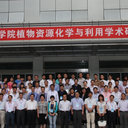Structure-immunomodulatory activity relationships of Hedysarum polysaccharides extracted by a method involving a complex enzyme combined with ultrasonication.
Sleutelwoorden
Abstract
A new, more effective and environmentally friendly method involving a complex enzyme combined with ultrasonication was employed to extract and isolate three novel polysaccharides (HPS-MCs: HPS-MC, HPS-MC (50%) and HPS-MC (80%)) of Radix Hedysari. Compared with polysaccharides obtained using a traditional extraction method (hot water extraction, HPS-R), the yields and total carbohydrate contents of HPS-MCs were significantly higher. HPS-MC (80%) exhibited relatively strong immunomodulatory activity and a concentration-dependent dose-response relationship under cyclophosphamide (CP)-induced immunosuppressive conditions in mice models. To more comprehensively investigate the relationships between structural characteristics and immunomodulatory activity, HPS-MC (80%) was fractionated into three major homogeneous polysaccharide fractions (HPS-MC (80%)s: HPS-MC (80%)-1, HPS-MC (80%)-2, and HPS-MC (80%)-3). These three homogeneous polysaccharides had different mass percentages of monosaccharides species (rhamnose, arabinose, mannose, glucose, and galactose) by gas chromatography (GC) and different molecular weights and chain conformations by high-performance gel permeation chromatography coupled with multi-angle laser light scattering (HPGPC-MALLS), and promoted macrophage and splenocyte proliferation to different degrees. These findings indicated that HPS-MC (80%) had a prominent potential immune response, especially HPS-MC (80%)-2 and HPS-MC (80%)-3, and might be suitable candidates for functional foods or potential novel immunomodulators.


